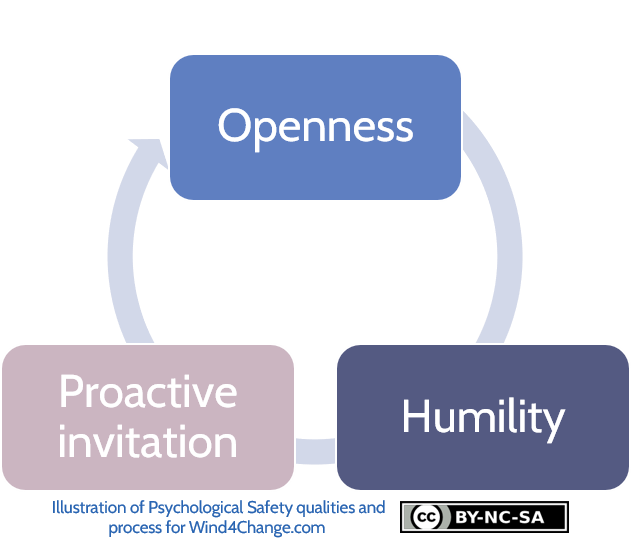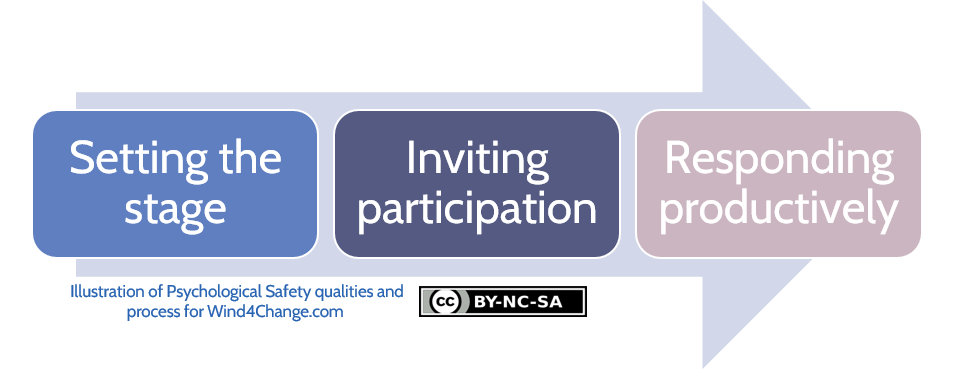How can Psychological Safety be improved? And how to create Psychological Safety at work?
Changing the relation to failure
Innovation comes with risk
If people do not have the right to fail, they will repeat safe recipes that were good enough in the past. Surely, this is not innovation but derivative improvement.
Therefore, the organization should understand failure not as something to fear or to try to avoid, but as an intrinsic part of learning and exploration. To summarize and divert the catch phrase: “No pain, no gain!”
Management of failure depends on the type of work
On one side is high-volume repetitive work such as in a factory or a fast-food restaurant. Without a doubt, failing to meet the performance standards may result in unsafe car or poison food with life of customers at stake. So, people should have a special concern to catch and correct deviation from performance standards. As a consequence, even if primary objective is to keep failure low, management should praise people who catch failures and identify deviation from performance standards.
On the other side is innovation and research where unknown is high about how to achieve the objective. For instance, creation of movies and technology like software development fall in this category. Truly here, if there is no risk, then no failure, there can be no innovation. Therefore, management should play down failure as they are part of the journey to success.
The types of failure
Firstly, preventable failures are process deviation: errors or faults
Preventable failures happen in basic utilities and services like factory or a fast-food restaurant.
They are deviations from performance standards that produce unwanted outcomes. Indeed, the causes are the behaviors, the skills and / or a lack of attention. But the performance standards and their implementation can also be the reason. Surely, complex and illogical process combined with poor tooling are the ground for errors. Therefore, the solution is training, enforcing good behavior and improving performance standards, processes and tooling. Nevertheless, all faults, conscious and / or repeated violation of performance standards, irresponsible behaviors should lead to sanction.
Secondly, complex failures: still errors or faults
Complex failures happen in hospital care, nuclear power plant or in space program.
They are the result of complexity that is some case generates a new combination of events and actions with poor or bad outcomes. The main causes are too much complexity, variability and even new factors. Thus, management should support communication and collaboration. As shown above, this comes with Psychological Safety. Clearly, this enables different points of view for a better analysis of the reasons of failure and identification of the risk factors to address. As a result, performance standards, processes and tooling will improve.
Thirdly, intelligent failures: likely failures coming with the risks taken to innovation
Intelligent failures happen in environment where innovation is at the center: drug development and software development, for instance.
They are unsuccessful trials. As a matter of fact, exploring new territory most of the time comes with unexpected, poor or bad outcomes. Indeed, the reasons are the uncertainty of the environment and sometimes the target. Also the risk taking as part of the experimentation.
Therefore, management here should accept and even celebrate those who take risks. They also should suggest ways to mitigate risk and get the most of it. To illustrate, Agile “fail fast” means fail quick, cheap and smart. So, next try will get closer to the objective. In addition, detailed analysis of the results and proper design of next experiment will support the path to success.
Reframing perception about failure
Failure is source of data
Failure is a source of valuable data but this data emerges only in environment with Psychological Safety. Truly here, no news does not mean good news. Some organization coined the expression watermelon KPI: it is green outside and red inside. Indeed, people may come with a red indicator and the result is that their management blames them and ask them to fix the problem. Then, next time, the KPI will be green. And the management will just has lost the visibility on the reality of the field. In fact, low reporting of failure is an indicator about how low the Psychological Safety is in an organization.
Grant right to failure to enable innovation
You cannot blame people and at the same time ask them to take risks and even fail fast. Therefore, management should work hard to play failure low. In some disruptive organization like X the innovation laboratory of Google, failure is even rewarded when it prevents money wasting.
Change vision on failure related to innovation and improvement
- Firstly, revise concept from “failure is not acceptable” to “failure is a natural by-product of experimentation“.
- Secondly, change belief from “effective performers don’t fail” to “effective performers produce, learn from and share the lessons from intelligent failures“.
- Thirdly, adjust the goal with failure in innovation from “prevent failure” to “promote fast learning“.
- At last, the result is that people move from “hiding failures to protect themselves” to “discuss openly failure, learn fast and innovate“.
Prevent failure empowering people
The more complex and uncertain the environment, the more important people are in preventing failure on standard tasks. Indeed, people empowerment to prevent failure comes with 3 steps. They are based on uncertainty, interdependence, and understand what is at stake:
- Firstly, emphasizing uncertainty reminds people that they need to be curious and alert to pick up early indicators of change. To illustrate, this may be customer preferences, new technologies emerging or unexpected reactions.
- Secondly, highlighting interdependence so people know that they are responsible for understanding how their tasks interact with other people’s tasks.
- At last, clarifying what is at stake. For instance, people will overpass interpersonal risk barrier and speak up when they have in mind that they are in an environment where life is at stake.
Changing the role of the manager to create Psychological Safety
All managers in the organization whatever the level are responsible for creating and reinforcing Psychological Safety. Clearly, if they do not collectively, nothing will happen. Indeed the organization is a system. Some Psychological Safety can happen at the level of teams. But there is a need for the organization culture to embrace it and to enforce a consistency. Without a doubt, The manager cannot protect the team from all the interactions with the rest of the organization.
In addition, salient hierarchy are a limit to create Psychological Safety. Indeed, the greater “power distance,” how the power is distributed between high-status and low-status members, the more difficult it is to build Psychological Safety. Another limitation is the excessive confidence in authority. In case of risk, people tend to consider that the manager knows best.
Agile Leadership comes with a change of paradigm
From a manager as a boss who has the answers, gives orders and assesses the performance to his or her staff.
To an Agile Leader who sets the direction, creates the conditions for learning and invites his staff to provide input and to contribute to improvement.
This has also a consequence on the staff with a switch from obedience to commitment.
Openness, humility and proactive invitation

Agile Leadership supports Psychological Safety with openness, humility and proactive invitation
Openness
If a manager only welcomes good news, fear will block all other information and the reality of the field. Actually, too much silence in a team is usually a sign that the team has been shut up by its manager.
Humility
Humility is a pragmatic answer to the complex, dynamic and uncertain world we are leaving in. A good way for the Agile Leader to demonstrate humility is by acknowledging his or her fallibility. And by accepting he or she does not have all the answers. When the Agile Leader clearly says that he or she does not know, this makes people free to explore their own ideas instead waiting for their Agile Leader what to do. Surely, when people share their ideas, then listening should come.
Proactive invitation
The Agile Leader proactively invite people to share concerns. To illustrate, he or she goes to them.
Setting the stage, inviting participation, and responding productively

The Agile Leader can create and improve Psychological Safety through 3 steps: setting the stage, inviting participation, and responding productively. Moreover, he or she will use repeatedly these practices in collaboration with his or her staff to build a climate favorable to Psychological Safety.
Setting the stage
This first step is about sharing the expectations about failure, uncertainty, and interdependence to clarify the need for speaking up. Then, the Agile Leader emphasizes what’s at stake, why it matters, for whom and makes it appealing.
Inviting
In the second step, the Agile Leader invites people a genuine and compelling way. At start, he or she also demonstrates humility acknowledging the gaps.
Then, the Agile Leader uses 2 simple tools. First ask questions that are by nature inviting and second listen carefully with concern the answers. Indeed, people should feel that they matter and so what they say. In addition, all those questions are an opportunity to reconnect with the appealing purpose.
Ask open questions that do no limit to a “yes” or “no” and powerful questions that provoke, inspire, and shift people’s thinking. Furthermore, listen to all answers even the boring ones. Surely, you do not want the speaking to stop.
At last, Agile Leaders also have the option to implement a dedicated structure. It will reinforce participation, psychological safety and make people feedback as part of a routine.
Responding Productively
Everything collapse without the last step and how the Agile Leader responds when people actually speak up. A constructive response is appreciative, respectful, and offer a path forward. Whatever the quality of the suggestion, remark or question, the first response should be to thank the person and to share appreciation.
Clearly, people take a risk speaking, so Agile Leaders should support that and reinforce the climate of Psychological Safety. Therefore, the Agile Leader de-stigmatizes failure looking forward for improvement and proposing help. But clear violation of performance standards should still trigger sanctions.
Measuring Psychological Safety with survey and quiz
There are several tools to measure Psychological Safety, but survey is the most popular. It is based on a 5 or 7 point Likert scale (from strongly agree to strongly disagree).
Of course, the survey should be anonymous and be filled in a psychologically safe environment. Here are the 7 questions proposed in the book the Fearless Organization from Amy Admondson.
1) If I make a mistake in this team, it is held against me.
2) Members of this team are able to bring up problems and tough issues.
3) People on this team sometimes reject others for being different.
4) It is safe to take a risk in this team.
5) It is difficult to ask other members of this team for help.
6) No one on this team would deliberately act in a way that undermines my efforts.
7) Working with members of this team, my unique skills and talents are valued and utilized.
What’s next? Learn more about Psychological Safety, Agile Leadership and Coaching
- Read my other post about what is Psychological Safety at work and its benefits.
- Review my other post about Agile Leadership and Host Leadership.
- Check my other posts on coaching for instance on:
Do you want to learn more about Psychological Safety? Here are some valuable references
- The Fearless Organization, the great book from Amy C. Edmondson that is one of the best reference on the topic. It is the main source of this post.
- TEDx video from Amy C. Edmondson on the topic.
- Some articles from Amy C. Edmondson on the topic:
- The 4 Stages of Psychological Safety, the good book from Timothy R. Clark.
- A post on 5 or 7 Point Likert Scale
